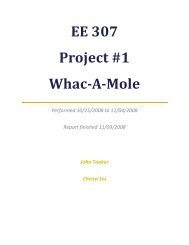A Discussion of the Life of Heinrich Friedrich Emil Lenz - jtooker.com
A Discussion of the Life of Heinrich Friedrich Emil Lenz - jtooker.com
A Discussion of the Life of Heinrich Friedrich Emil Lenz - jtooker.com
Create successful ePaper yourself
Turn your PDF publications into a flip-book with our unique Google optimized e-Paper software.
discovered some <strong>of</strong> <strong>the</strong>se laws himself before learning <strong>of</strong> Ohm‟s work (Ohm 613). In addition to<br />
his understanding <strong>of</strong> <strong>the</strong> significance <strong>of</strong> <strong>the</strong>se laws, he also “knew how to <strong>com</strong>bine <strong>the</strong>m<br />
quantitatively,” (Stine 73).<br />
The results <strong>of</strong> this study show: “The electromotive power, which a magnet produces in a<br />
-3-<br />
Tooker<br />
spiral with convolutions <strong>of</strong> equal magnitude, and with a wire <strong>of</strong> equal thickness and like substance, is<br />
directly proportional to <strong>the</strong> number <strong>of</strong> its convolutions.” Defined in C. G. S. units (Centimeter,<br />
Gram, Seconds) as opposed to M. K. S. units (Meter, Kilogram, Second, known as SI after 1960)<br />
(Stine 74; Rowlett):<br />
Continuing his detailed description, in <strong>the</strong> second experiment <strong>of</strong> this paper, <strong>Lenz</strong> describes<br />
his apparatus: “I wound <strong>the</strong> copper wire in six convolutions around a wooden wheel 28 inches in<br />
diameter, and placed <strong>the</strong> wheel on <strong>the</strong> iron cylinder. After having <strong>com</strong>pleted <strong>the</strong> experiment, I<br />
wound six convolutions <strong>of</strong> <strong>the</strong> same wire about <strong>the</strong> same iron cylinder.” He found <strong>the</strong> acting<br />
electromotive forces were almost identical leading him to conclude, “The electromotive power<br />
which <strong>the</strong> magnetism produces in <strong>the</strong> surrounding spiral, is <strong>the</strong> same for every magnitude <strong>of</strong> <strong>the</strong><br />
convolutions” (Stine 75).<br />
Testing different diameters <strong>of</strong> wire, each 33 feet in length and wound ten times, he noted <strong>the</strong><br />
resistance <strong>of</strong> each wire was negligible, despite <strong>the</strong>ir different diameters. The electromotive force was<br />
constant for each <strong>of</strong> <strong>the</strong>se three tests. He generalizes, “The electromotive power produced in <strong>the</strong><br />
spirals by <strong>the</strong> magnet, remains <strong>the</strong> same for every thickness <strong>of</strong> <strong>the</strong> wire or is independent <strong>of</strong> it,”<br />
(Stine 75-76).<br />
The next <strong>of</strong> <strong>Lenz</strong>‟s discoveries states, “<strong>the</strong> electromotive power, which <strong>the</strong> magnet produces<br />
in spirals <strong>of</strong> wire <strong>of</strong> different substances, under like conditions, is <strong>the</strong> same for all substances,” (Stine<br />
76). Modern research <strong>of</strong>ten fails to give <strong>Lenz</strong> accreditation for this simple principle, despite its<br />
importance and usefulness. “Ferro-magnetic winding, whose permeability is greater than unity, such<br />
materials affect <strong>the</strong> value <strong>of</strong> <strong>the</strong> factor dN and mask <strong>the</strong> final result,” (Stine 76-77).<br />
Reflecting on <strong>the</strong> results <strong>of</strong> previous magnetic research around his geographical area, <strong>Lenz</strong><br />
states, “Nobili and Antinori, in <strong>the</strong>ir first paper on <strong>the</strong> electrical phenomena produced by <strong>the</strong><br />
magnet, have already determined <strong>the</strong> order in which four different metals are adapted to produce <strong>the</strong><br />
electric current from magnetism. They arrange <strong>the</strong>se in <strong>the</strong> following order: copper, iron, antimony,<br />
and bismuth.”<br />
“It is particularly striking that <strong>the</strong> order is <strong>the</strong> same as that which <strong>the</strong>se metals occupy, also in<br />
reference to <strong>the</strong>ir capacity <strong>of</strong> conducting electricity: and <strong>the</strong> idea suddenly occurred to me, whe<strong>the</strong>r<br />
<strong>the</strong> electromotive power <strong>of</strong> <strong>the</strong> spirals did not remain <strong>the</strong> same in all metals; and whe<strong>the</strong>r <strong>the</strong><br />
stronger current in <strong>the</strong> one metal did not arise from its being a better conductor <strong>of</strong> electricity,”



